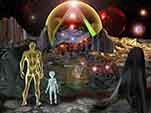After some further research, it appears that the age of Iron you refer to and the Age of Kali are one and the same. It appears to have begun 5100 years ago, however.
As to when it will end exactly, I have found nothing so far except the slight reference to this celebration being about its end. You do, however bring up an interesting point in the 1,000 year interval inbetween. Let us conjecture that we are at this respite point at the beginning of the 1,000 years of peace. This would fit in nicely with Nostradamus' 'thousand years of peace, would it not?' Don't know about you, but I am ready for a break!!! And a thousand years of peace and creativity are just the ticket!
FOLLOWING IS MORE INFORMATION ABOUT THIS AGE:
On the New Moon night at the end of Phalguna (February), in the year 3102 BC, all planets lined up in one direction on one side of the planet earth. And on the other side over India, the dark planet Rahu hovered invisibly in the night. This marked the close of the Dvapara Age and the beginning of the Kali- yuga, the Age of Darkness.
A simple calculation tells us that this is Kali Y5100-- the turn of yet another century in this ongoing dreadful age. In fact, this year March 18 (Chaitra sukla 1) marks the Fifty First Centennary Disappearance Anniversary of Lord Sri Krishna and first day of the New Kali-yuga Year.
Kali Yuga 5100: Introduction
--------------------------------------------------------------------------------
The progression of yugas from Satya to Kali is one of a successive decline so deeply rooted and all-pervasive that it amounts to a sort of ontological decay; the power of life seems to be eroded by the force of time. The character of this decline is expressed by a familiar metaphor of the yugas as Ages of Gold, Silver, Copper and Iron.
Dharma is supported by four pillars in Satya-yuga: cleanliness, austerity, mercy and truthfulness. In each succeding age, one leg is removed, until in Kali-yuga, dharma is balanced precariously on truthfulness alone, and even that erodes as the age progresses.
The human lifespan, set at 100,000 in Satya-yuga, is diminished in each yuga by a factor of ten reaching only a 100 years in Kali-yuga, our age. Each age also brings about a reduction in the earth's productive energy, so that food loses more and more of its sustaining power, until by Kali-yuga people are mental, physical, moral and spiritual runts compared with their status in the golden age. Stature, strength, stamina, memory and intelligence are all meager.
Prior to the start of this age, the great sage Vyasa prophetically saw all this in his meditation:
Vyasa sees the effects of chronic malnutrition on generation after generation; he watches it gradually diminish their span of life along with their brain power; no one can escape the progressive drop in intelligence and ability to remember.
The harrassment of hard times upon an increasingly witless populace hastens its moral and spiritual decline. People begin to slaughter animals for food; they become more and more enslaved by drugs; they lose all sexual restraint. These habits further their physical and mental deterioration. Vyasa watches them sink deeper annd deeper into sensuality and ignorance. Families break up, and women and children are abandoned. Increasingly degraded generations, conceived accidentally in lust and growing up wild, swarm over the earth. Leadership falls into the hands unprincipled criminals who use their power to loot the people. The world teems with ideologues, mystagogues, fanatics, and spiritual bunko atrists who win huge followings among a people dazed by social and moral anarchy. Unspeakable depravities and atrocities flourish under a rhetoric of high ideals.
It is interesting, by the way, that the Vedic date assigned to the advent of Kali-yuga (c. 3000 BC) corresponds closely to the date set by modern historians for the rise of civilized life, an event signalled by the appearance of literacy and the emergence of complex urban socities.
All that historians recognize as recorded human history is, in fact, only human history in Kali-yuga. The academic historians' ignorance of the earlier and incalculably higher Vedic civilization is what we have to expect from people suffering from the mental retardation imposed by the times. We see symptoms of this intellectuual degradation of modern thinkers in their avowal that sense perception is the only source of knowledge and in their obliviousness to the dependence of knowledge upon goodness. Inverted values warp their ideas, such as the conviction that human progress resides in the proliferation of complex urban societies and increasingly sophisticated technology.
They are unaware that simple living is the best basis for high thinking, and that a truly advanced civilzation minimizes exploitation of nature and social complexity. They do not know that the real standard of progress is the caliber of the people it produces. If we pursue material advancement at the expense of self-realization, measuring our standard of living only by the gratification of our senses, then we will only get a spiritually and morally debilitated people in control of an intricate and powerful technology--a terrifying combination that leads to horors on a scale we are just beginning to experience.
Excerpted from:
Ravindra-svarupa dasa (http://www.rsdtm.com) "Spiritual Strategies for the Age of Iron" in Encounter with the Lord of the Universe, 1983
"ISKCON's Historical Self Perception" in Krishna Consciousness in the West, 1998
a blip of some thousand years where there is
: a return of a mini golden age, which is temporary
: and will allow some relief






































